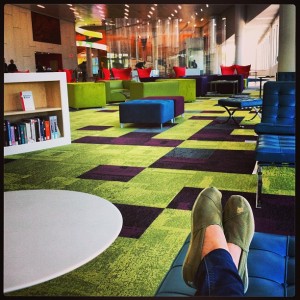On August 15, North Carolina State University Libraries (NCSU Libraries) in Raleigh released lentil, open-source software that supports the harvesting of images and image metadata from Instagram. It enables organizations “to build special collections based around a topic or event, or to invite participation in evaluating a library program,” according to a release.
The program was initially developed to help collect photos of NCSU’s new James B. Hunt Jr. Library, which opened in January 2013 and will be profiled in LJ’s upcoming Library by Design supplement. Since the new library was designed with an emphasis on “visually inspiring” work areas and collaborative spaces, NCSU wanted to encourage students, researchers, and community members to collaborate and tell the story of the new facility.
“We were thinking about what our social media strategy for the library was going to be, and we noticed that students were already taking pictures of our [other] libraries on their own…. Kind of capturing their daily life,” explained Mike Nutt, digital media librarian for NCSU Libraries. “Because the new library was a very visual place and would have this striking architecture … we had a reasonable expectation that people would be taking pictures of it. We wanted to harness that energy and provide a platform for student engagement that was really all about them, and the ways that they would be using the library.” The “My #HuntLibrary” platform was the result.
To add their photos of the library to the broader collection, visitors simply used the hashtag #HuntLibrary on shots uploaded to Instagram. My #HuntLibrary then harvests these photos for an NCSU website, and allows users to participate in the curation process, voting on their favorites using “likes” or by picking favorites using a “battle” feature that pits two photos against each other.
The platform employs responsive web design techniques, allowing users to view photo submissions on screens as small as four inches or as large as the Hunt Library’s new visualization walls. Rebroadcasting recently taken photos on these visualization walls was one creative way that NCSU Libraries built buzz around the project.

An image from My #HuntLibrary by Julea Wood
“One of the most fun parts of the project for me—and I think for the students too—was that we put these pictures up [on the video wall] using lentil,” Nutt said. “So students, after taking a picture could see the pictures on the video wall. That was one of the things that helped give the project momentum…. Once they could see the photos, not just on their mobile phones but in this public venue, they really started to participate.”
Ultimately, more than 2500 photos were submitted. This collection will now be preserved in the university’s archives by the NCSU Libraries Special Collection Research Center, according to the announcement.
“Taking the messaging and promotion of the library out of our publicity office and putting it into the hands of our students was really more successful than anyone had anticipated,” Nutt said. “We were all surprised and pleased at how well that worked. And now that the publicity push is over, I think there’s an opportunity to start using these pictures for learning the ways that our patrons are using the building.”
NCSU Libraries has now made the code for My #HuntLibrary project freely available on GitHub in the lentil Rails Engine framework. It enables the harvesting of image files and metadata from Instagram, and allows an administrator to moderate submissions and add items to a collection. Lentil also includes a tool that makes it easy to submit agreements to contributors when seeking permission to reuse their photos for additional promotional or research purposes, according to the announcement. Developers can use the code to customize and deploy lentil-based applications on any Ruby on Rails-capable server.
“Part of the impetus behind open-sourcing it was that we were curious about what other people would do with it,” Nutt said. “That’s one of the exciting things for us—to see what kinds of unexpected uses people might have for it.”


